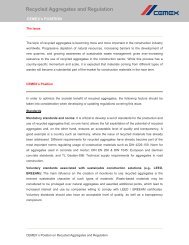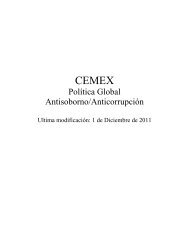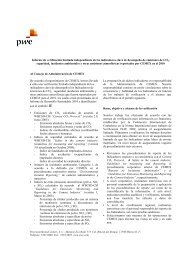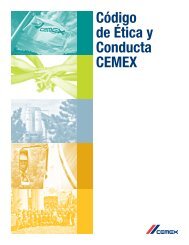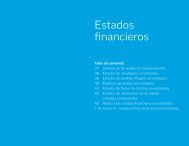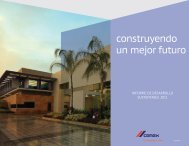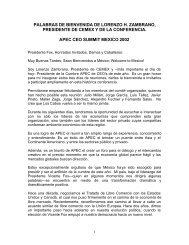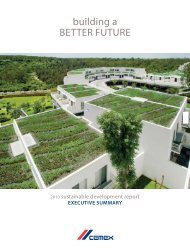building a STRONGER foundation - Cemex
building a STRONGER foundation - Cemex
building a STRONGER foundation - Cemex
You also want an ePaper? Increase the reach of your titles
YUMPU automatically turns print PDFs into web optimized ePapers that Google loves.
Competition. The Costa Rican cement industry includes three producers: CEMEX Costa Rica, Holcim Costa Rica and Cementos<br />
David.<br />
Exports. During 2010, cement exports by our operations in Costa Rica represented approximately 20% of our total production in<br />
Costa Rica. In 2010, 9% of our cement exports from Costa Rica were to El Salvador, and the remaining exports were to Nicaragua.<br />
Capital Expenditures. We made capital expenditures of approximately U.S.$7 million in 2008, U.S.$3 million in 2009 and<br />
U.S.$10 million in 2010 in our operations in Costa Rica. We currently expect to make capital expenditures of approximately U.S.$5<br />
million in our operations in Costa Rica during 2011.<br />
Our Operations in the Dominican Republic<br />
Overview. As of December 31, 2010, we held 100% of CEMEX Dominicana, S.A., or CEMEX Dominicana, our main<br />
subsidiary in the Dominican Republic and a leading cement producer in the country. CEMEX Dominicana’s sales network covers the<br />
country’s main consumption areas, which are Santo Domingo, Santiago de los Caballeros, La Vega, San Pedro de Macoris, Samana<br />
and Bavaro. CEMEX Dominicana also has a 14-year lease arrangement with the Dominican Republic government related to the<br />
mining of gypsum, which has enabled CEMEX Dominicana to supply all local and regional gypsum requirements.<br />
tons.<br />
The Cement Industry in the Dominican Republic. In 2010, cement consumption in the Dominican Republic reached 3.0 million<br />
Competition. Our principal competitors in the Dominican Republic are Domicem, a mixed Italian/local cement producer that<br />
started cement production in 2005; Cementos Cibao, a local competitor; Cemento Colón, an affiliated grinding operation of Argos;<br />
Cementos Santo Domingo, a cement grinding partnership between a local investor and Cementos La Union from Spain; and Cementos<br />
Andinos, a Colombian cement producer which has an installed grinding operation and a partially constructed cement kiln.<br />
Description of Properties, Plants and Equipment. As of December 31, 2010, CEMEX Dominicana operated one cement plant in<br />
the Dominican Republic, with an installed capacity of 2.6 million tons per year. As of that date, CEMEX Dominicana also owned 10<br />
ready-mix concrete plants, one aggregates quarry, two land distribution centers and two marine terminals.<br />
Capital Expenditures. We made capital expenditures of approximately U.S.$12 million in 2008, U.S.$6 million in 2009 and<br />
U.S.$11 million in 2010 in our operations in the Dominican Republic. We currently expect to make capital expenditures of<br />
approximately U.S.$7 million in our operations in the Dominican Republic during 2011.<br />
Our Operations in Panama<br />
Overview. As of December 31, 2010, we held a 99.5% interest in Cemento Bayano, S.A., or Cemento Bayano, our main<br />
subsidiary in Panama and a leading cement producer in the country. As of December 31, 2010, Cemento Bayano operated one cement<br />
plant in Panama, with an installed capacity of 2.1 million tons per year. As of that date, Cemento Bayano also owned and operated 15<br />
ready-mix concrete plants, three aggregates quarries and three land distribution centers.<br />
On February 6, 2007, we announced our expansion project to build a new kiln at our Bayano plant in Panama. The project was<br />
completed in the fourth quarter of 2009 and reached stable operations in the first quarter of 2010. Additional capital expenditures were<br />
required in 2010 due to a change in the scope of the project, and some expenditures are expected to be made in 2011. The new kiln<br />
increased our cement installed capacity to 2.1 million tons per year. As of December 31, 2010, we have spent approximately U.S.$239<br />
million on the new kiln, which includes U.S.$31 million in 2007, U.S.$104 million in 2008, U.S.$83 million in 2009 and U.S.$21<br />
million in 2010. We currently expect to make capital expenditures of approximately U.S.$19 million in 2011.<br />
The Cement Industry in Panama. Approximately 1.4 million cubic meters of ready-mix concrete were sold in Panama during<br />
2010, according to our estimates. Cement consumption in Panama decreased 7.8% in 2010, according to our estimates.<br />
Competition. The cement industry in Panama includes two cement producers: Cemento Bayano and Cemento Panamá, an<br />
affiliate of Colombian Cementos Argos.<br />
Capital Expenditures. We made capital expenditures of approximately U.S.$118 million in 2008, U.S.$88 million in 2009 and<br />
U.S.$32 million in 2010 in our operations in Panama, which include those related to the expansion of the Bayano plant described<br />
above. We currently expect to make capital expenditures of approximately U.S.$29 million in our operations in Panama during 2011.<br />
60



